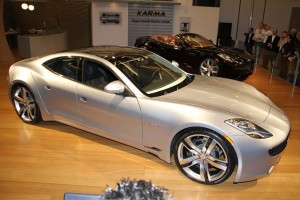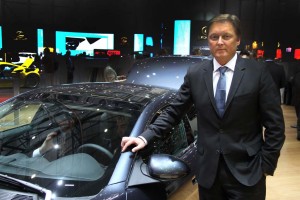More than three years after announcing plans to produce a high-performance plug-in hybrid, Danish designer-cum-entrepreneur Henrik Fisker is ready to put his money – and a half billion dollars of U.S. taxpayer cash – where his mouth is.
The sleek Fisker Karma coupe officially goes into production on March 21st, after several earlier delays. How it fares could reveal whether the automotive market is open to new players, like Fisker Automotive, ready to challenge the traditional industry order by focusing on environmentally-friendly powertrain technology.
These days, there are dozens of automotive wannabes hoping to cash in on the green movement. They’ve collectively raised billions from investors and entrepreneurs who believe this is the first real opening since the U.S. automotive ranks began to dwindle during the Great Depression. And some have been able to count on the help of the federal treasury, the Obama Administration approving billions of dollars in loans and grants intended to promote electric propulsion.
The situation “is similar to 100 years ago when we moved from the horse and buggy but the choice between steam, electric and gasoline wasn’t clear yet,” suggests Fisker, who first made a name for himself as a designer of high-performance sports cars like the Aston Martin DB9.

The 2011 Fisker Karma will get 50 miles on battery power alone, but should launch from 0 to 60 in 5.9 seconds, with a 125 mph top speed.
The eponymous Fisker Automotive has cashed in on the government largesse, landing a $528 million federal loan – and using some of that money to purchase an old General Motors assembly plant in Delaware that the maker abandoned as part of its bankruptcy.
That plant will – if all goes well – produce a second Fisker product line, codenamed Project Nina, a reference to the flagship of Christopher Columbus’ flagship when he discovered the New World.
But the first big test will come with the launch of the Karma, a $95,900 sports car that has won raves for its sexy design. It remains to be seen how the car’s driveline will be received.
Though it targets a high-line audience – which may be more willing to shell out for an unusual exotic like the Karma – Fisker’s first offering has much in common with the recently-released Chevrolet Volt. Both are billed as “extended-range electric vehicles,” rather than plug-in hybrids because the wheels are primarily driven by electric power, even when their batteries run down.
While Fisker waits for final word from U.S. regulators, he says the company expects to get about 50 miles per charge of Karma’s lithium-ion batteries. Even when those batteries run down, the vehicle’s backup internal combustion engine will take over and provide a total range of 300 miles before a driver needs to either fill up or recharge. Preliminary estimates suggest the Karma will be rated at 67 mpg, compared with the smaller, slower Volt’s 93 mpg.
Karma is expected to launch from 0 to 60 in just 5.9 seconds, nearly twice as fast as Volt – but also a tenth of a second quicker than the new Porsche Panamera S Hybrid.
Fisker will offer three versions of Karma, including the “base” model, the $104,500 Karma EcoSport and the $108,000 EcoChic, which will provide a buyer virtually all possible options.
Asked how he will differentiate Fisker Automotive from the numerous other battery-car start-ups, Fisker insists his management team “has a different strategy, which is to create a real car company rather than just being a niche manufacturer.”
In a lengthy interview, he notes that the Karma “isn’t a hand-built car,” like the original Tesla Roadster, but produced on a mainstream assembly line. For the company’s first offering, Fisker turned to Valmet, a contract assembler in Finland that produces a variety of specialty vehicles. Later this month, Karma will begin rolling down the line alongside the Porsche Boxster, which Valmet also produces.
The Danish-born Fisker, who now bases his operation in Southern California, claims to have 3,000 firm orders in hand. First-year production will ramp up slowly, but the target is 15,000 in 2012. If they meet that number, he effuses, “We’re going to have a great profit.”
Like virtually everyone connected to the world of battery power, Fisker is reluctant to discuss specific costs. Just two years ago, most experts set the price of a lithium-ion battery at $1,000 per kilowatt-hour, though it appears prices are dropping, some makers now believed to be paying between $600 and $800 per kWh. Insiders at Nissan say the Japanese maker believes it can get down to just over $300 per kWh during the life of the new Leaf battery-electric vehicle program.
For his part, Fisker acknowledges battery technology is improving, both in cost and in metrics like power density, size and weight, “though not as quickly as we’d like.” Part of the challenge is making sure that newer formulations can survive the harsh demands of the automotive environment, not just work on a small scale in a smartphone or MP3 player.
But driving down costs will be critical for Fisker Automotive if it hopes to come up with a viable second product, the eventual Project Nina vehicle anticipated to cost perhaps half as much as Karma.
Like Karma, the next model will be a plug-in. Fisker has made a firm decision to steer clear of pure battery-electrics, like the Leaf or Tesla’s upcoming Model S. The costs are too high, he suggests, and he is not convinced there’s a market for vehicles with limited range and extensive charging times.
On the other hand, “My prediction is that for the next five years, (the industry) can sell as many extended-range vehicles as they can build.”
While he admits that approach is “more complex and costly,” Fisker is confident consumers will pay the premium to get vehicles that are green – without limiting their mobility.
With the first Karma coupes about to roll off the line, Fisker’s philosophy – and his billion-dollar investment – will soon be put to the test.

